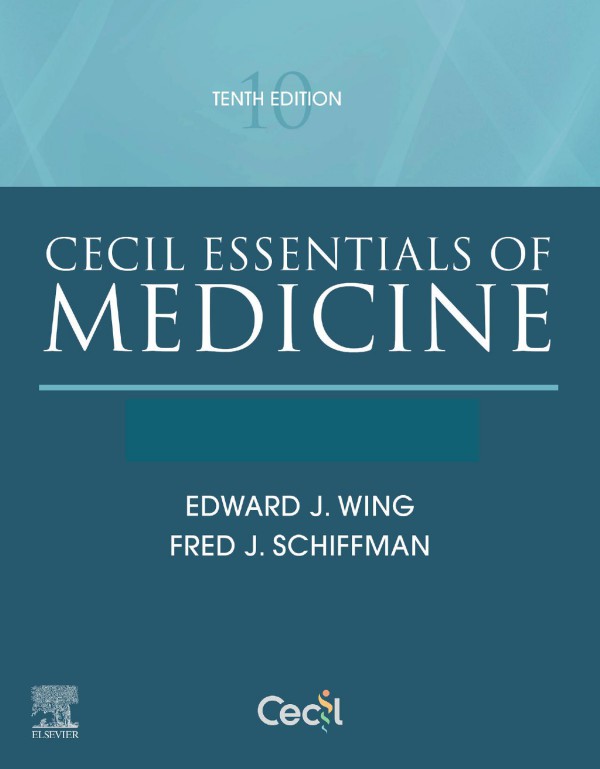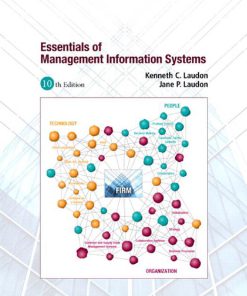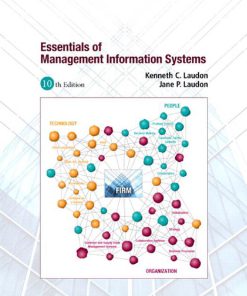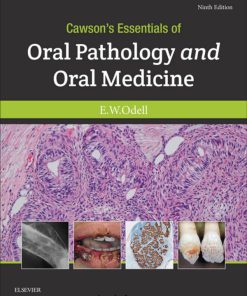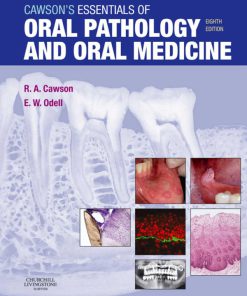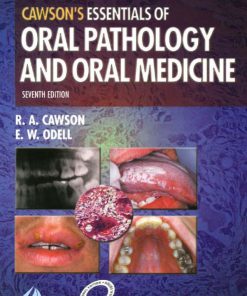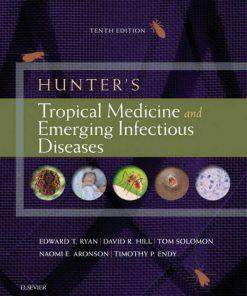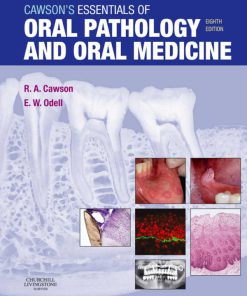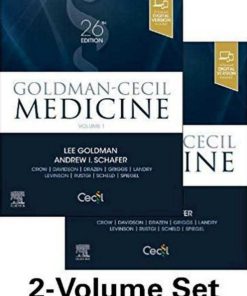Cecil Essentials of Medicine 10th Edition by Edward Wing,Fred Schiffman 9780323722735 0323722733
$50.00 Original price was: $50.00.$25.00Current price is: $25.00.
Authors:Edward J. Wing MD FACP FIDSA (editor), Fred J. Schiffman MD MACP (editor) , Series:Medicine [88] , Author sort:Edward J. Wing MD FACP FIDSA (editor), Fred J. Schiffman MD MACP (editor) , Ids:9780323722711 , Published:Published:Mar 2021 , Publisher:Elsevier Inc.
Cecil Essentials of Medicine 10th Edition by Edward Wing,Fred Schiffman- Ebook PDF Instant Download/Delivery.9780323722735,0323722733
Full download Cecil Essentials of Medicine 10th Edition after payment
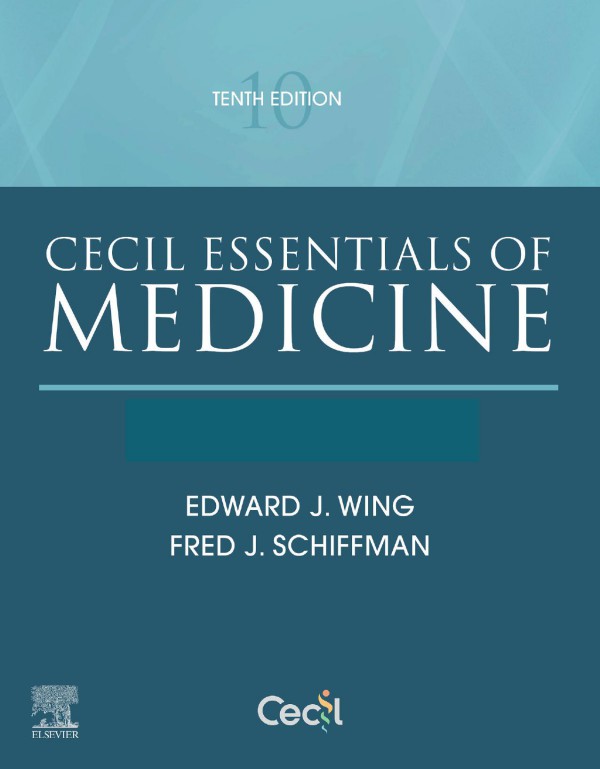
Product details:
ISBN 10:0323722733
ISBN 13:9780323722735
Author:Edward Wing,Fred Schiffman
Known for its concise, easy-to-read writing style and comprehensive coverage, Cecil Essentials of Medicine has been a favorite of students, residents, and instructors through nine outstanding editions. This revised 10th Edition continues the tradition of excellence with a focus on high-yield core knowledge of key importance to anyone entering or established in the field of internal medicine. Fully revised and updated by editors Edward J. Wing and Fred J. Schiffman, along with other leading teachers and experts in the field, Cecil Essentials remains clinically focused and solidly grounded in basic science.
- New focus on high-yield, core knowledge necessary for clerkships or residencies in medicine, with concise, complete coverage of the core principles of medicine and how they apply to patient care.
- Each section describes key physiology and biochemistry, followed by comprehensive accounts of the diseases of the organ system or field covered in the chapters.
- Full-color design enhances readability and retention of concepts, while numerous imaging videos cover cardiovascular disease, endoscopy, sphincterotomy, and more.
- Superb images and photographs vividly illustrate the appearance and clinical features of disease.
- New chapters cover Women’s Cancer and Transitions in Care from Children to Adults with Pulmonary Disease.
Cecil Essentials of Medicine 10th Table of contents:
SECTION I. Introduction to Medicine
1. Introduction to Medicine
SECTION II. Cardiovascular Disease
2. Structure and Function of the Normal Heart and Blood Vessels
Definition
Circulatory Pathway
Conduction System
Neural Innervation
Myocardial Structure
Muscle Physiology and Contraction
3. Evaluation of the Patient With Cardiovascular Disease
Definition and Epidemiology
Pathology
Clinical Presentation
Diagnosis and Physical Examination
4. Diagnostic Tests and Procedures in the Patient With Cardiovascular Disease
Electrocardiography
Abnormal Electrocardiographic Patterns
Ambulatory Electrocardiographic Recording
Chest Radiography
Echocardiography
Nuclear Cardiology
Cardiac Magnetic Resonance Imaging
Stress Testing
Stress Imaging
Computed Tomography of the Heart
Cardiac Catheterization
Endomyocardial Biopsy
Noninvasive Vascular Testing
5. Heart Failure and Cardiomyopathy
Definition and Classification
Pathophysiology
Diagnosis and Management Of Acute Decompensation
Future Directions
6. Congenital Heart Disease
Introduction
Acyanotic Heart Disease
Cyanotic Heart Disease
7. Valvular Heart Disease
Introduction
Aortic Stenosis
Mitral Stenosis
Pulmonic Stenosis
Tricuspid Stenosis
Aortic Regurgitation
Mitral Regurgitation
Pulmonic Regurgitation
Tricuspid Regurgitation
8. Coronary Heart Disease
Definition and Epidemiology
Risk Factors for Atherosclerosis
Pathology
Clinical Presentations of Coronary Artery Disease
Prognosis
9. Cardiac Arrhythmias
Basic Cellular Electrophysiology
General Approach to Management
Bradycardia
Tachycardias
Syncope
Ventricular Arrhythmias and Sudden Cardiac Death
Summary
10. Pericardial and Myocardial Disease
Pericardial Disease
Diseases of the Myocardium
11. Other Cardiac Topics
Cardiac Disease in Pregnancy
Cardiac Tumors
Traumatic Heart Disease
Percutaneous Mechanical Circulatory Support
Noncardaic Surgery in the Patient With Cardiovascular Disease
12. Vascular Diseases and Hypertension
Introduction
Systemic Vascular Disease
Pulmonary Vascular Disease
Venous Thromboembolic Disease
Arterial Hypertension
Treatment of Hypertension
Prognosis
Prospects for the Future
SECTION III. Pulmonary and Critical Care Medicine
13. Lung in Health and Disease
Introduction
Lung Development
Pulmonary Disease
Prospectus for the Future
14. General Approach to Patients With Respiratory Disorders
Introduction
Clinical Presentation
History
Physical Examination
Evaluation
Prospectus for the Future
15. Evaluating Lung Structure and Function
Introduction
Anatomy
Physiology
Evaluation of Lung Function
Evaluation of Lung Disease
Prospectus for the Future
16. Obstructive Lung Diseases
Introduction
Chronic Obstructive Pulmonary Disease
Bronchiolar Disorders
Bronchiectasis
Cystic Fibrosis
Asthma
17. Interstitial Lung Diseases
Overview
Idiopathic Interstitial Lung Diseases
Exposure-Related Ilds
ILD Due to Systemic Diseases
Summary
18. Pulmonary Vascular Diseases
Introduction
Pulmonary Hypertension
Other Types of Pulmonary Hypertension
Pulmonary Thromboembolism
Prospectus for the Future
19. Disorders of the Pleura, Mediastinum, and Chest Wall
Pleural Disease
Mediastinal Disease
Chest Wall Disease
Prospectus for the Future
20. Respiratory Failure
Introduction
Pathophysiology
Classification of Respiratory Failure
Specific Clinical Situation: Acute Respiratory Distress Syndrome
21. Transitions in Care From Pediatric to Adult Providers for Individuals With Pulmonary Disease
Introduction
Cystic Fibrosis and Other Mucociliary Diseases
Asthma and Bronchopulmonary Dysplasia
Diffuse Lung Disease (Interstitial Lung Disease)
Individuals with Technology Dependence or Other Special Health Care Needs
Importance of a Successful Transition
SECTION IV. Preoperative and Postoperative Care
22. Preoperative and Postoperative Care
Introduction
Cardiac Disease
Identification of Patients with Elevated Risk
Preoperative Cardiac Risk Assessment
Preoperative Risk Modification to Reduce Perioperative Cardiac Risk
Postoperative Cardiac Risk Assessment
Noncardiac Surgery in Patients with Specific Cardiovascular Conditions
Renal Disease
Hepatic Disease
Pulmonary Disease
Endocrine Disease
Hematologic Disease
Infectious Disease
Neurologic Disease
Rheumatologic Disease
Special Needs of the Geriatric Patient
Summary
SECTION V. Renal Disease
23. Renal Structure and Function
Introduction
Renal Structure
Renal Function
24. Approach to the Patient With Renal Disease
Introduction
Approach to the Patient with Chronic Kidney Disease
Approach To The Patient With Acute Kidney Injury
25. Fluid and Electrolyte Disorders
Normal Volume Homeostasis
Hyponatremia
Hypernatremia
Hypokalemia
Hyperkalemia
Metabolic Acidosis
Metabolic Alkalosis
Respiratory Alkalosis
Respiratory Acidosis
26. Glomerular Diseases
Introduction
Clinical Presentation
Clinical Syndromes
Primary Podocytopathies
Immune-Complex Glomerulonephritis
Glomerular Diseases Caused By Plasma Cell Dyscrasias
Fibrillary Glomerulonephritis and Immunotactoid Glomerulopathy
Glomerulonephritis Associated with Viral Infections
Thrombotic Microangiopathies
Diseases with Glomerular Basement Membrane Abnormalities
Fabry’s Disease
Diabetic Nephropathy
27. Major Nonglomerular Disorders of the Kidney
Introduction
Acute Interstitial Nephritis
Chronic Interstitial Nephritis
Cystic Kidney Diseases
Tuberous Sclerosis
Von Hippel–Lindau Disease
Kidney Tumors
Nephrolithiasis
28. Vascular Disorders of the Kidney
Introduction
Renal Vascular Anatomy
Renovascular Disease
Thrombotic Microangiopathy of the Kidney
Antiphospholipid Antibody Syndrome
Renal Vein Thrombosis
29. Acute Kidney Injury
Definition
Etiology
Epidemiology
Diagnostic Evaluation
Clinical Presentation, Differential Diagnosis, and Management of AKI
Complications of AKI
General Management of AKI
Outcome and Prognosis of AKI
30. Chronic Kidney Disease
Definition and Epidemiology
Pathology
Clinical Presentation
Diagnosis
Treatment
Prognosis
SECTION VI. Gastrointestinal Disease
31. Common Clinical Manifestations of Gastrointestinal Disease: Abdominal Pain
Definition and Epidemiology
Physiology
Causes of Abdominal Pain
Clinical Presentation
Acute Abdomen
Chronic Abdominal Pain
32. Common Clinical Manifestations of Gastrointestinal Disease: Gastrointestinal Hemorrhage
Introduction
Approach to PatientS with Gastrointestinal Bleeding
33. Common Clinical Manifestations of Gastrointestinal Disease: Malabsorption
Definition and Epidemiology
Digestion and Absorption of Fat
Digestion and Absorption of Carbohydrates
Digestion and Absorption of Proteins
Mechanisms of Malabsorption
Clinical Presentation
Diagnosis
Treatment
Malabsorptive Therapy
34. Common Clinical Manifestations of Gastrointestinal Disease: Diarrhea
Definition
Pathophysiology
Evaluation of Acute Diarrhea
Chronic Diarrhea
35. Endoscopic and Imaging Procedures
Introduction
Gastrointestinal Endoscopy
Nonendoscopic Imaging Procedures
Prospectus for the Future
36. Esophageal Disorders
Introduction
Symptoms of Esophageal Disease
Diagnostic Studies of the Esophagus
Structural Disorders
Gastroesophageal Reflux Disease and Sequelae
Motility Disorders
Variant Forms of Esophagitis
Esophageal Infections
Esophageal Trauma and Emergencies
Systemic and Other Illnesses
37. Diseases of the Stomach and Duodenum
Introduction
Anatomy
Histology
Histology of the Duodenum
Gastroduodenal Secretions
Gastroduodenal Motility
Peptic Ulcer Disease
Zollinger-Ellison Syndrome
Gastritis
Functional (Nonulcer) Dyspepsia
Cyclic Vomiting Syndrome
Rapid Gastric Emptying
Gastroparesis
Gastric Volvulus
38. Inflammatory Bowel Disease
Introduction
Epidemiology
Risk Factors and Pathophysiology
Clinical Presentation
Diagnosis and Differential Diagnosis
Treatment
Prognosis
39. Diseases of the Pancreas
Acute Pancreatitis
Chronic Pancreatitis
Carcinoma of the Pancreas
SECTION VII. Diseases of the Liver and Biliary System
40. Laboratory Tests in Liver Diseases
Introduction
Liver Chemistry Tests
Liver Synthetic Function
41. Jaundice
Introduction
Bilirubin Metabolism
Laboratory Measurement of Bilirubin
Unconjugated Hyperbilirubinemia
Neonatal Jaundice
Conjugated Hyperbilirubinemia
Clinical Approach to the Evaluation of Jaundice
42. Acute and Chronic Hepatitis
Introduction
Acute Hepatitis
Chronic Hepatitis
43. Acute Liver Failure
Definitions
Pathogenesis
Clinical Presentation
Diagnosis
Treatment
Prognosis
44. Cirrhosis of the Liver and Its Complications
Liver Cirrhosis
Complications of Cirrhosis
Variceal Hemorrhage
Ascites
Spontaneous Bacterial Peritonitis
Hepatorenal Syndrome
Hepatic Encephalopathy
Hepatopulmonary Syndrome and Portopulmonary Hypertension
Hepatocellular Carcinoma
Vascular Disease of the Liver
Liver Transplantation
45. Disorders of the Gallbladder and Biliary Tract
Introduction
Normal Biliary Anatomy and Physiology
Gallbladder Disorders
Biliary Tract Disorders
SECTION VIII. Hematologic Disease
46. Hematopoiesis and Hematopoietic Failure
Hematopoiesis
Primary Hematopoietic Failure Syndromes
Prospectus for the Future
47. Clonal Disorders of the Hematopoietic Stem Cell
Introduction
Myeloproliferative Neoplasms
Polycythemia Vera
Essential Thrombocythemia
Primary (Idiopathic) Myelofibrosis
Chronic Myelogenous Leukemia
Acute Leukemias
Prospectus for the Future
48. Disorders of Red Blood Cells
Normal Red Blood Cell Structure and Function
Clinical Presentation
Laboratory Evaluation
Evaluation of Hypoproliferative Anemias
Evaluation of Anemia With Reticulocytosis
Prospectus for the Future
49. Clinical Disorders of Granulocytes and Monocytes
Introduction
Normal Granulocyte Development, Structure, and Function
Determinants of Peripheral Neutrophil Numbers
Neutrophilia
Neutropenia
Prospectus for the Future
50. Disorders of Lymphocytes
Introduction
Lymphocyte Development, Function, and Localization
Neoplasia of Lymphoid Origin
Congenital and Acquired Disorders of Lymphocyte Function
51. Normal Hemostasis
Introduction
Vasculature Physiology
Von Willebrand Factor
Platelet Physiology
Coagulation
52. Disorders of Hemostasis: Bleeding
Introduction
Hemostasis
Clinical Evaluation of Bleeding
Laboratory Evaluation of Bleeding
Bleeding Caused by Vascular Disorders
Bleeding Caused by Thrombocytopenia
Bleeding Caused by Platelet Function Defects
Bleeding Caused by Von Willebrand Disease
Bleeding Caused by Coagulation Factor Disorders
Bleeding in Patients with Normal Laboratory Values
Prospectus for the Future
53. Disorders of Hemostasis: Thrombosis
Pathology Of Thrombosis
Clinical Evaluation Of Thrombosis
Therapy For Venous Thromboembolism
SECTION IX. Oncologic Disease
54. Cancer Biology
Introduction
The Genetics of Cancer
The Tumor Microenviroment
Hallmarks of Cancer
55. Cancer Epidemiology
Introduction
Cancer Epidemiology Methods
Risk Factors
Cancer Prevention
Cancer Screening
56. Principles of Cancer Therapy
Introduction
Diagnosis and Staging
Principles of Cancer Surgery
Principles of Radiation Therapy
Principles of Medical Therapy
Evaluation of Response
Supportive Care
57. Lung Cancer
Definition and Epidemiology
Pathology
Clinical Presentation
Diagnosis and Differential Diagnosis
Treatment
Prognosis
58. Gastrointestinal Cancers
Introduction
Esophageal Cancer
Gastric Cancer
Pancreatic Cancer
Cholangiocarcinoma (Bile Duct Cancers)
Hepatocellular Carcinoma
Colorectal Cancer
Anal Cancer
59. Genitourinary Cancers
Renal Cell Carcinoma
Bladder Cancer
Prostate Cancer
Testicular Cancer
60. Breast Cancer
Epidemiology
Risk Factors
People also search for Cecil Essentials of Medicine 10th:
the routledge international handbook of critical positive psychology
routledge international handbook of critical issues in health and illness
the routledge international handbook of critical education
the routledge international handbook of critical autism studies
routledge international handbook of critical mental health

